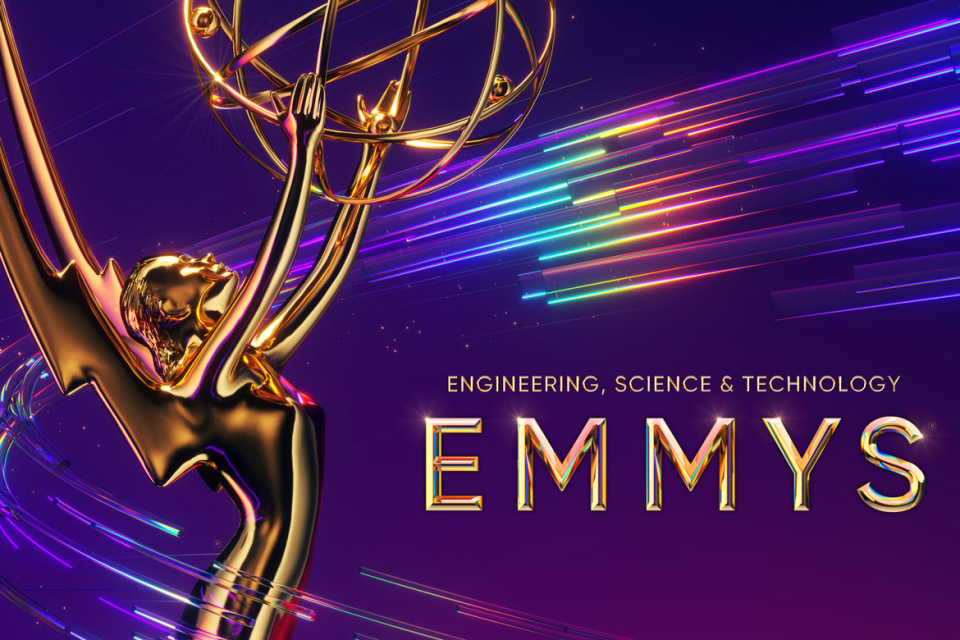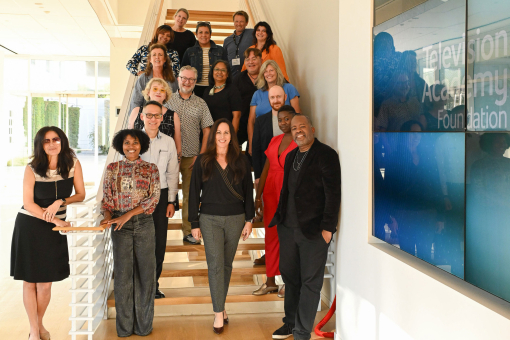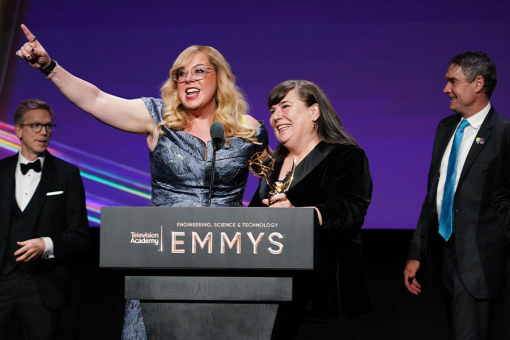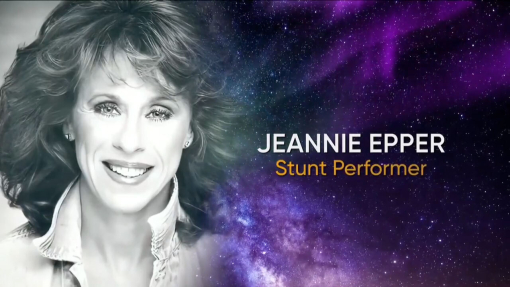The Television Academy today announced the recipients of the 76th Engineering, Science & Technology Emmy Awards honoring an individual, company or organization for developments in broadcast technology. The awards ceremony, hosted by Criminal Minds star Kirsten Vangsness, will be held on Wednesday, Oct. 23, 2024, at the Television Academy's Saban Media Center in North Hollywood, California.
"The Engineering, Science & Technology Emmy Awards are a testament to the incredible ingenuity and creativity that power our industry," said Cris Abrego, chair of the Television Academy. "We are thrilled to honor these innovators who have pushed the boundaries of what's possible, shaping the future of television for generations to come."
"This year we honor a diverse group of technologies that enable and advance the storytelling process for television production," said committee co-chairs Barry Zegel and Wendy Aylsworth. "Electro/Mechanical Camera Stabilization systems, software programs that aid the editing and creation process, support for LED Volumes production, the MDDF (MovieLabs Digital Distribution Framework) Standard, and the use of generative artificial intelligence tools are all included in this year's awards. This wide range of technologies demonstrates the amazing achievements throughout our industry."
The Engineering, Science & Technology Emmy Awards are made possible by Television Academy sponsors FIJI Water, Franciacorta, Johnnie Walker Blue Label, JUSTIN Vineyards & Winery, People, The Ritz-Carlton and United Airlines.
The following is a list of awards and recipients to be recognized:
Charles F. Jenkins Lifetime Achievement Award
Honors a living individual whose ongoing contributions have significantly affected the state of television technology and engineering.
Recipient: Jensen Huang
Jensen Huang founded NVIDIA in 1993 and has served since its inception as president, chief executive officer and a member of the board of directors.
Since its founding, NVIDIA has pioneered accelerated computing. The company's invention of the GPU (graphics processing unit) in 1999 sparked the growth of the PC gaming market, redefined computer graphics and ignited the era of modern AI. NVIDIA is now driving the platform shift of accelerated computing and generative AI, transforming the world's largest industries and profoundly impacting society.
Huang has been elected to the National Academy of Engineering and is a recipient of the Semiconductor Industry Association's highest honor, the Robert N. Noyce Award; the IEEE Founder's Medal; the Dr. Morris Chang Exemplary Leadership Award; and honorary doctorate degrees from Taiwan's National Chiao Tung University, National Taiwan University and Oregon State University. He has been named the world's best CEO by Fortune, the Economist and Brand Finance and one of TIME magazine's 100 most influential people.
Prior to founding NVIDIA, Huang worked at LSI Logic and Advanced Micro Devices. He holds a BSEE degree from Oregon State University and an MSEE degree from Stanford University.
For more information, please visit NVIDIA.com.
Philo T. Farnsworth Corporate Achievement Award
Honors an agency, company or institution whose contributions over time have significantly impacted television technology and engineering.
Recipient: Adobe Inc.
Adobe is changing the world through personalized digital experiences. For over 40 years, Adobe has been a leader in delivering groundbreaking technology that empowers everyone, everywhere to express themselves and bring their stories to life.
From students to creative professionals, and from small businesses to the world's largest enterprises, Adobe's customers use Adobe tools to unleash their creativity, accelerate document productivity and power digital businesses — including Adobe Acrobat; Creative Cloud tools such as Premiere Pro, Photoshop, After Effects and Adobe Express; Substance 3D collection; collaboration tools like Frame.io; and Experience Cloud enterprise solutions, such as Adobe GenStudio.
Adobe's tools have powered a record number of award-winning television shows and movies including 2024 Emmy-nominated projects, such as Saturday Night Live, FX's The Bear and HBO's Ramy Youssef: More Feelings and The Jinx — Part Two as well as noteworthy films and docuseries including Thank You, Goodnight: The Bon Jovi Story, Dìdi (弟弟) and Penelope.
For more information, please visit Adobe.com.
Engineering, Science & Technology Emmy Awards
Presented to an individual, company or organization for developments in engineering, science and technology that are either so extensive an improvement on existing methods or so innovative in nature that they materially affect the production, recording, transmission or reception of television and thereby have elevated the storytelling process.
Recipient: Adobe Inc. for the development of the Adobe Substance Painter
Substance Painter is a non-destructive 3D texture painting application. Initially built for game developers, Substance Painter has seen very quick adoption in visual effects and animation within the television industry despite its relatively young age. Substance Painter's unique approach of procedural-driven materials differs from previous metaphors for texture generation: It leverages algorithmic methods vs. manual painting and cloning. This has enabled fast and creative texture creation by a broader spectrum of artists without requiring traditional art and painting skill sets. This new workflow has helped increase creativity and accelerate asset generation via quicker iterations in visual effects. As a result, Substance 3D Painter is leading the industry in texture painting, allowing the ability to texture a model in real-time. From animation to visual effects studios, the industry uses Painter to bring their creations to life.
For more information, please visit Adobe.com.
Recipients: Tom Ohanian, Ken Goekjian, Joel Swan and Victor Young for the development of the Avid Multicamera System
Introduced in 1994, the Avid Multicamera System has stood the test of time. With its worldwide usage, it continues to be a dominant technology and product offering in the industry. The Multicamera System replaced systems that utilized videotape and laserdisc players. This digital multicamera invention improved upon all the previous limitations: It provided nonlinear, digital, random access to material with multiple tracks of audio. Due to the invention's functionality of auto-synchronization, the time-consuming synchronization of different camera angles was automated. Editing could proceed directly from camera iso (isolated) feeds as well as a line cut (directly from the video switcher), if necessary due to time constraints. These items significantly advanced the art of storytelling, proving why creative people utilize Avid's Multicamera System to make today's most celebrated video and audio content.
For more information, please visit Avid.com.
Recipients: Paul Pan, Yanchong Zhao, Tie Su, Shimeng Bei for the development of the DJI Ronin Series
The DJI Ronin is a line of professional camera stabilization systems designed for filmmakers and videographers to stabilize cameras, enabling camera operators to capture smooth, steady footage. The Ronin uses a three-axis gimbal system to stabilize pan, tilt and roll, keeping the camera level and steady, often eliminating the need to lay dolly track or set up a Technocrane. The Ronin's modular design allows for easy setup and adjustment and can be adapted for a variety of shooting scenarios and camera setups. Ronin's payload capacity supports a variety of camera and lens combinations from small mirrorless cameras to larger cinema cameras. Ronin gimbals offer a variety of operation modes, such as Pan Follow, Lock Mode and POV (Point of View) Mode; and they are compatible with a range of accessories, such as wireless focus systems, monitors and other filmmaking tools.
For more information, please visit DJI.com.
Recipients: Stuart Geman, Kevin Manbeck, John Mertus, and Michael Braca for the development of the DRS™Nova Film and Video Restoration Software
DRS™Nova film and video restoration software boasts a comprehensive suite of features tailored to meet the diverse needs of modern filmmakers and post-production experts. From its inception, this innovative software has been at the forefront of advancements in digital restoration and film-processing technology, continuously evolving to keep pace with the ever-changing demands of the industry. It seamlessly integrates into the workflows of film labs, post-production houses, and archival facilities, providing robust solutions for a wide array of restoration tasks. Whether it's restoring aging film stock, enhancing visual quality, or preparing content for television broadcast and streaming, or Blu-ray distribution, DRS™Nova excels in delivering exceptional results with unmatched efficiency. By empowering professionals to achieve their creative vision while maintaining the integrity of the original content, DRS™Nova has played a pivotal role in preserving cinematic heritage and elevating the quality of visual storytelling across various platforms.
For more information, please visit MTIFilm.com.
Recipient: Benjamin Graf for the development of Accentize's dxRevive Pro
dxRevive Pro is a sophisticated speech-restoration plugin engineered to enhance the fidelity of dialogue recordings across a range of scenarios. Unlike other restoration-style software, dxRevive Pro doesn't just filter the signal, it also identifies and reintegrates missing frequency components. As a result, users can produce studio-like recordings (where the audio is not only "cleaned" but the dialogue itself is enhanced) from a diverse array of source materials. Previously, achieving such clarity required painstaking effort and might not have been achievable at all, resulting in the need for ADR sessions and the additional cost and time those incur. By swiftly and effectively improving dialogue quality, dxRevive Pro elevates the overall audio experience for viewers, ensuring that they can be fully immersed in the story without distraction or discomfort. In essence, dxRevive Pro not only mitigates the impact of budget constraints on dialogue quality but also enhances the storytelling process by providing a more comfortable listening experience, ultimately enriching the narrative and its emotional impact.
For more information, please visit Accentize.com.
Recipients: Jeremy Hochman, Chris Byrne, Colin Cook and Justin Nicolaides for the development of Megapixel's HELIOS LED Processing Platform
The HELIOS platform is an advanced video processing system for LED walls. For over 20 years, the platform has revolutionized LED displays, making them reliable and repeatable tools for filmmakers. HELIOS' advancement of LED processing has removed the restrictions of greenscreen production, enabling storytellers to have full creativity — live in camera. HELIOS supports video sources up to 8K resolution and is capable of handling up to four simultaneous SMPTE ST 2110 inputs. This makes it ideal for large-scale displays and complex visual applications that require high-resolution and precise synchronization. HELIOS' innovative GhostFrame technology allows multiple unique video feeds to be displayed on LED panels simultaneously, streamlining virtual production workflows by enabling the recording of multiple backgrounds from a single take. Its advanced color-management system ensures accurate color fidelity, consistently preserving and applying metadata from source to final display. With full HDR support and seamless integration with image-based lighting systems, HELIOS delivers stunning visuals.
For more information, please visit megapixelvr.com.
Recipients: Craig Seidel for the development of the MovieLabs Digital Distribution Framework
The MovieLabs Digital Distribution Framework (MDDF) was born from the evolution from physical to digital distribution. Starting in mid-2008, MDDF was originally conceived to support online sales of downloadable content, but it rapidly evolved into a comprehensive collection of essential data standards that drove online streaming. Prior practice was for content owners to provide distribution services an assortment of spreadsheets, emails and other unstructured data. When volumes were small these manual methods could work; but as distribution services evolved to handle tens or hundreds of thousands of titles (millions of assets), those practices were no longer feasible. MDDF provides the solution. MDDF is a suite of digital distribution specifications that define avails (licensing); metadata; asset ordering, delivery and status; bonus/extras; workflows; and APIs. MDDF was designed to get movies and television in front of home viewers in the form most suitable for their needs. It allows a breadth of content to be prepared and delivered by digital service providers to viewers with rich metadata that supports discovery allowing viewers to select the most interesting content. MDDF supports full localization, both in metadata and in handling the complexity of localized and accessibility-focused assets and supports everything from the most primitive formats to the most advanced. MDDF allows people to enjoy content in a way that preserves the creative intent and matches the needs of the individual.
For more information, please visit MovieLabs.com.
Recipient: The Tiffen Company for the development of the Steadicam Volt™
The Steadicam Volt™ system is an accessory to the already ubiquitous Steadicam that utilizes electronic stabilization technology to assist camera operators in achieving and maintaining smooth, consistent and level camera shots. When mounted on a Steadicam or other brand of camera stabilizer, the Volt will help to maintain a level or preset horizon and filter out unwanted camera movements without affecting normal Steadicam operation or control. Steadicam Volt™ consists of two main components: A "brain" that is mounted fixed in relation to the camera, which houses all gyro and accelerometer motion-sensing components and a gimbal-mounted "motor drive" unit to apply corrections to the tilt-and-roll axis of the camera stabilizer. With the camera stabilizer sled neutrally balanced, the Volt requires very little battery power to manipulate even the heaviest of camera payloads. Difficult shots that involve high-acceleration camera movement — such as running or fast lateral movements — are now easier to obtain smoothly. Operators do not need to focus as much on inertial influences or external forces, such as wind and how they affect camera positioning. The Steadicam Volt™ enables a camera operator to better focus, react and interact with dynamically changing or challenging shooting environments to produce better framing of shots.
For more information, please visit Tiffen.com.
###
Stephanie Goodell
breakwhitelight (for the Television Academy)
Stephanie@breakwhitelight.com
818.462.1150
For the complete press release, click here.













